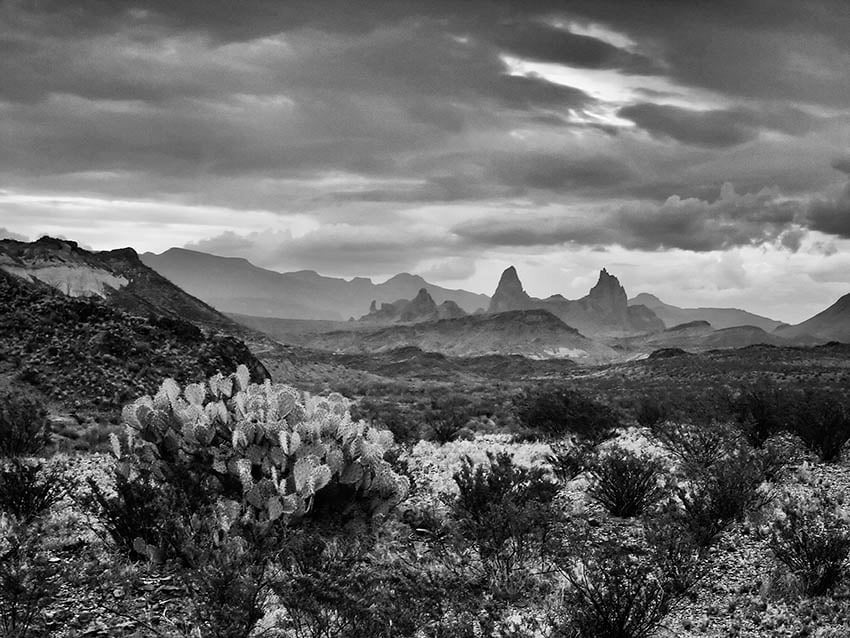Born of Land and Sea: Meet Photographer Charles “Dennis” McKelroy
Charles “Dennis” McKelroy has been honing his love of nature for a lifetime. Spending his childhood summers scouting and camping, he worked as a sea captain for much of his adult life, traveling the world with a camera in hand. Along the way, he developed an appreciation for the outdoors that he continues to express through photography.
Soul-Soothing Scenery
Dennis likes to say that he seeks a story around every corner. He believes that by consistently taking photos, he has begun to “see in pictures.” Beyond simply owning a camera, he says practice, patience, location research, and imagination are all required.
He applies all those things to the wildlife and wide-open spaces that are frequent subjects of his work. Take “Mull’s Ears” featured below. With its desert, mountains, and open skies, Big Bend National Park in west Texas holds a special place in his heart. The photo “Thinking It Over,” shown above, is testimony to Dennis’s patience: How often do we see a hummingbird at rest?!
Roots in Film
In the early days of his photography journey, Dennis worked with film, a medium that required meticulous attention to composition, lighting, and film exposure. The process was not without its challenges, including the cost and the anticipation of seeing the results only during the print phase. However, these hurdles only fueled his passion and deepened his understanding of photography, a knowledge that continues to shape his work today.

See More of Dennis’s Work
Explore this Texan's online portfolio for a deeper dive into his color and black-and-white photography. From the serene marshes where osprey soar to windswept fields of sunflowers, his artistry is a testament to his curiosity in finding beauty in unexpected places. To learn more about his journey and his most indispensable tool, check out my Q&A with Dennis below.
Now for Artie’s Eight Q&A with Charles “Dennis” McKelroy…
1. What is your background; how did you get started?
Right after high school in the 1970s, a friend introduced me to photography. My first camera, an Instamatic with tiny film negatives, grabbed my interest and imagination. I continued advancing from there, purchasing self-help and how-to books and taking a couple of correspondence and college courses in photography. My job had me traveling around America and other parts of the globe, always carrying a camera.
2. How important is it for a photographer to "connect" with their subject?
Ansel Adam stated: "You don't make a photograph with just a camera. You bring to photography all the pictures you have seen, books you have read, music you have heard, and people you have loved." To make the image work, one needs to understand how to capture the viewer's imagination by drawing them into the photograph. That is accomplished by understanding the laws of nature and the ability to see in pictures. One mentor put it this way: "By constantly using the camera, one begins to see in pictures." This requires many hours of practice, patience, researching locations, and, of course, one's imagination.
3. What has been a formative experience or the best advice you’ve received within your career?
I traveled to many exotic, remote locations while using film-based cameras. There were no redos, so capturing the moment with limited frames required understanding the medium of film and camera. In college, we worked with black-and-white film and learned to develop and print our photos. Those two experiences have elevated my understanding of a photograph's creation even as we entered the digital age.
4. In what ways does your work reflect your personality?
My profession was a sea captain. The ability to think quickly on my feet while remaining vigilant in my surroundings has been an asset. I notice things that most people would not see — or would take for granted in their everyday surroundings. Plus, I have the patience to wait as a potential subject comes together.
5. Creative blocks, do you get them? If so, how do you overcome them?
Yes. It usually involves viewing other photographers' work. Then, my imagination seeks out what may be within my grasp locally that might fill a void in my portfolio. I don't want to capture the same image; instead, I think of new possibilities.
6. What is your most indispensable tool? (Not counting the obvious, like paints, brushes, canvas, camera, etc.)
The ability to use imaging software. My equipment is a professional Canon camera, and my imaging software is Photoshop with several plug-ins. I started with PS in the early '90s and have continued to advance using it as Adobe advanced their technology.
7. Do you have a new project you are working on, or a new passionate idea?
I am currently working on scanning early images taken using negative film and positive slide images. Recently, I have been putting together some local photographs as prints or to share as note cards.
8. What "fad" gadget do you most regret purchasing?
With the cost of photographic equipment, I've not purchased any "fad" gadgets. But I have invested in a few items that I have not yet gotten around to using.
All artwork and/or photographs used in this post are subject to copyright held by the featured artist.
ARE YOU READY FOR THE SPOTLIGHT? Simply respond to the questionnaire here to apply to be included in an upcoming Artie’s Eight Spotlight.
Last Updated June 17, 2024